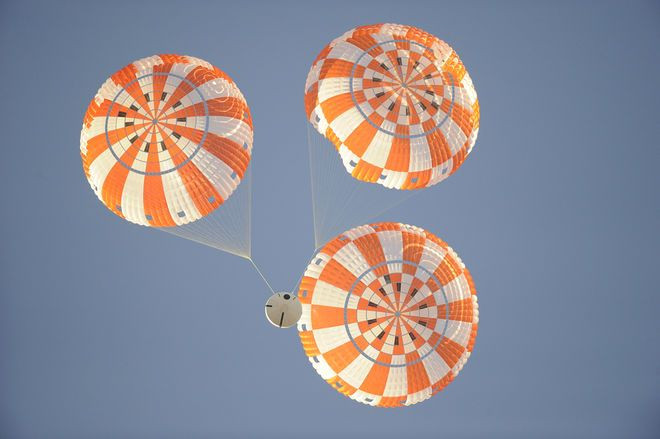NASA's Replica Orion Spacecraft's Drop-Test Footage Studying Complex Parachute System Released

NASA’s Orion mission is an upcoming Multi-Purpose Crew Vehicle (MPCW), which is under development for launch on the Space Launch System (SLS) designed to carry humans into deep space in the future. It is currently undergoing stringent testing and development at NASA. The latest success in the project came when NASA tested out the parachute landing system for Orion in the southwestern Arizona desert.
A replica of the Orion spacecraft was released from an Air Force transport aircraft Friday to land at a desert site in southwestern Arizona. The test was conducted to see if the spacecraft could cope with a partial parachute failure during re-entry into Earth’s atmosphere.
This step is crucial to the mission’s success because when NASA’s Orion spacecraft hurtles toward Earth’s surface, 11 parachutes are all that will break its fall will reach speeds of 300 mph during entry to a relatively gentle 20 mph before splashdown in the Pacific Ocean, all in the span of 10 minutes.
The threads that hold the parachute to the craft need to be rugged to withstand the heat and friction. The scientists tested a scenario where only two of the three parachute systems deploy. Interestingly, it managed to land even with only two systems (each system had 3 smaller orange and white chutes) working.
“Through our testing, we’ve addressed some known failures that can happen in complex parachute systems to make the system more reliable,” said Koki Machin, chief engineer for the parachute system in a NASA release. “We built upon the strong foundation laid by Apollo engineers and figured out how to manage the stresses on the system during deployment more efficiently, decrease the mass of the parachutes by using high tech fabric materials rather than metal cables for the risers that attach the parachute to the spacecraft, and improve how we pack the parachute into Orion so they deploy more reliably.”
The Orion is much larger than the Apollo and the parachute system is more complex and stringent tests are required to make sure there are no snags during this very crucial step of the mission.
The parachute system of Orion consists of 11 parachutes in total, three out of which are forward bay cover parachutes, to be deployed first. From the three, two are drogue parachutes, which will be deployed at an altitude of 25,000 feet, and rest is a pilot parachute which is intended for deployment at approximately 9,500 feet.
About 10 miles of Kevlar lines attach the spacecraft to the outer rim of nearly 12,000 square feet of parachute canopy material, which cannot get tangled during deployment. The chutes are fired from cannons and must be timed to perfection to slow the craft down to 20mph.
“Orion’s parachute system is an extremely lightweight, delicate collection of pieces that absolutely must act together simultaneously or it will fail,” said Machin. “It alone, among all the equipment on the crew module, must assemble itself in mid-air at a variety of possible velocities and orientations.”
The team hopes to use the vast Apollo data and computer models when possible to test the landing gear. According to the team, drop tests will continue into 2018 with the latest one being the fifth test. The engineering team hopes to cut down from the 100s of test for Apollo’s gear to 20-25 tests for the Orion mission, which will hopefully propel humans past the moon onto Mars.
© Copyright IBTimes 2025. All rights reserved.





















